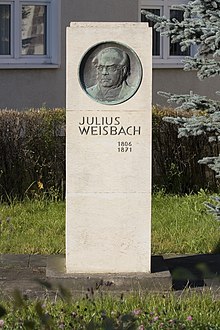Julius Weisbach

Julius Ludwig Weisbach (born 10 August 1806 in (now Mildenau Municipality), Erzgebirge, died 24 February 1871, Freiberg) was a German mathematician and engineer.
Life and work[]
Weisbach studied at the Bergakademie in Freiberg from 1822 - 1826. After that, he studied with Carl Friedrich Gauss in Göttingen and with Friedrich Mohs in Vienna.[1]
In 1831 he returned to Freiberg where he worked as mathematics teacher at the local Gymnasium. In 1833 he became teacher for Mathematics and the Theory of Mountain Machines at the Freiberg Bergakademie. In 1836 he was promoted to Professor for applied mathematics, mechanics, theory of mountain machines and so-called Markscheidekunst.[2]
Weisbach wrote an influential book for mechanical engineering students, called Lehrbuch der Ingenieur- und Maschinenmechanik, which has been expanded and reprinted on numerous occasions between 1845 and 1863.[3]
He also refined the Darcy equation into the still widely used Darcy–Weisbach equation.
In 1868 he was elected a foreign member of the Royal Swedish Academy of Sciences.
Family[]
His daughter Maria Camilla Weisbach (1835–1908) met Edward Carl Hegeler (1835–1910) when he was studying with her father at Freiberg and later married him on 5 April, 1860. The couple settled in LaSalle, Illinois, where Hegeler had set up the Matthiessen-Hegeler Zinc Company. Their daughter Mary Hegeler, later Carus, was born on 10 January 1861, the first of ten children. Mary worked alongside her father as a young girl and was the first woman to graduate from the University of Michigan with a bachelor's degree in engineering in 1882. In 1885 she became the first woman to be legally enrolled to study at her grandfather's university, Bergakademie Freiberg, following a letter of recommendation from her cousin Clemens Winkler.[4]
Selected publications[]
- Handbuch der Bergmaschinenmechanik (2 Bde., 1835/1836)
- Lehrbuch der Ingenieur- und Maschinenmechanik (3 Bde., 1845/1863)
- Der Ingenieur, Sammlung von Tafeln, Formeln und Regeln der Arithmetik, Geometrie und Mechanik (1848)
- Die neue Markscheidekunst und ihre Anwendung auf die Anlage des Rothschönberger Stollns bei Freiberg (1851)
- Anleitung zum axonometrischen Zeichnen (1857)
Notes[]
- ^ Wegert, Hebisch & Lyska, page 3.
- ^ Kurrer, page 868.
- ^ Mikhailov, page 1012.
- ^ Lohne, Raymond. "Mary Hegeler Carus". Immigrant Entrepreneurship. Retrieved 2021-03-27.
References[]
- Kurrer, Karl Eugen (2006). "Der Enzyklopädist der Technischen Mechanik des 19. Jahrhunderts – Zum 200. Geburtstag von Julius Weisbach (1806–1871)". Bautechnik (in German). 83 (12): 868–875. doi:10.1002/bate.200610076. ISSN 1437-0999.
- Mikhailov, G.K. (1994). "Hydrodinamics and Hydraulics". In Ivo Grattan-Guinness (ed.). Companion Encyclopedia of the History and Philosophy of the Mathematical Sciences. Routledge. pp. 1006–1022. ISBN 978-0-415-09239-5.
- Wegert, Elias; Hebisch, Udo; Lyska, Werner. "Julius Weisbach als Wegbereiter der angewandten Mathematik" (PDF). Fakultät für Mathematik und Informatik (in German).
External links[]
| Wikimedia Commons has media related to Julius Weisbach. |
- O'Connor, John J.; Robertson, Edmund F. "Julius Weisbach". MacTutor History of Mathematics archive. University of St Andrews.
- Rouse, Hunter (2008). "Weisbach, Julius Ludwig". Complete Dictionary of Scientific Biography. Retrieved 22 October 2016.
- 19th-century German mathematicians
- Engineers from Saxony
- University of Göttingen alumni
- Members of the Royal Swedish Academy of Sciences
- 1806 births
- 1871 deaths
- Scientists from Freiberg
- Fluid dynamicists